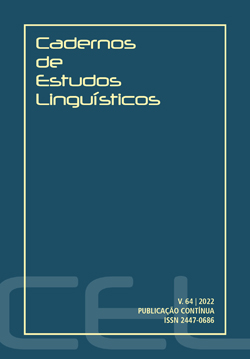Resumen
La escritura en portugués de los brasileños sordos se considera, en la literatura, difícil de entender debido principalmente a la falta de elementos cohesivos. La comprensión de que esto resulta de interlenguas intermedias y transitorias entre su primera lengua (L1), Libras, y la lengua de destino (L2), el portugués, motivó nuestra investigación sobre las características del conocimiento lingüístico que las gobierna. En este trabajo, investigamos la falta de elementos cohesivos en los textos bajo análisis y cómo estos elementos surgen a lo largo de la enseñanza y el aprendizaje con la metodología de enseñanza L2. Considerando los estudios en adquisición de L2 y la evolución de la enseñanza de estas lenguas en el área de Lingüística Aplicada, aplicamos una investigación-acción centrada en el discurso directo. Elaboramos materiales en los que utilizamos cómics como base textual, ya que estos favorecen la transposición de diálogos a un texto escrito en lenguaje lineal, lo que requiere una referencia explícita a los interlocutores y el uso de un verbo dicendi: elementos cohesivos y secuencia del habla ausentes de los textos iniciales de los aprendices. Los resultados de la investigación-acción nos llevaron a dos reflexiones: la primera, basada en la Lingüística Textual, se centra en la naturaleza de las fallas funcionales de las palabras en el aprendizaje de una L2, especialmente aquellas que tienen correspondencia directa en las dos lenguas involucradas, como los pronombres personales correspondientes, y la segunda aborda la cuestión metodológica relacionada con la oferta de abundante entrada integral vs. enfoque en forma, enseñando un L2.
Citas
ARAÚJO, M. N. O. Os espaços na Libras. Tese (Doutorado em Linguística) ¬ Instituto de Letras, Universidade de Brasília, Brasília, 2016.
BRITO, L. F. Por uma gramática da língua de sinais. Rio de Janeiro: Tempo Brasileiro, UFRJ, Departamento de Linguística e Filologia, 1995.
THE PEAR story (YouTube link). Produção de Wallace Chafe, 1975. Disponível em: htttp://pearstories.org/docu/ThePearStorie.htm. Acesso em: 10 jan. 2022.
DOUGHTY, C.; WILLIAMS, J. Focus on form in classroom second language acquisition. New York: Cambridge University Press, 1998.
ELLIS, R. The study of second language acquisition. Oxford: Oxford University Press, 1994.
ELLIS, R. Second language acquisition. Oxford University Press, 1997.
GASS, S. M.; SELINKER, L. Second Language Acquisition. 3. ed. New York: Routledge, 2008.
GRANNIER, D. M. Português-por-escrito para usuários de Libras. Revista Integração, ano 14, n. 24, p. 48-51, 2002.
GRANNIER, D. M.; ALMEIDA, J. A. Repensando a metodologia do ensino de português L2 a surdos (manuscrito).
HALLIDAY, M. A. K.; HASAN, R. Cohesion in English. London: Longman, 1976.
KOCH, I. V. A coesão textual. 21. ed. 2. reimpressão. São Paulo: Contexto, 2009.
KRASHEN, S. D. The input hypothesis. Issues and implications. Longman Group UK Ltd.1-32. ISBN: 0582553814, 1985.
LONG. M. e ROBINSON, P. Focus on form. In: DOUGHTY, C.; WILLIAMS, J. Focus on form in classroom second language acquisition. New York: Cambridge University Press, 1998. p. 17-41.
MARCUSCHI, L. A. Linguística de texto: o que é e como se faz? 3. ed. São Paulo: Parábola Editorial, 2012.
NEMSER, W. Approximative systems of foreign language learners. In: ERIC, U S Department of Health, Education & Welfare Office of Education, 1969. Disponível em https://files.eric.ed.gov/fulltext/ED026639.pdf. Acesso em: 12 jan. 2022.
NEVES, M. H. M. Gramática de usos do português. 2. ed. São Paulo: UNESP, 2011.
QUADROS, R. M.; KARNOPP, L.B. Língua de sinais brasileira: estudos linguísticos. Porto Alegre: Artmed, 2004.
QUADROS. R. M.; SCHMIEDT. M. Ideias para ensinar português para alunos surdos. Brasília: MEC, SEESP, 2006.
SABANAI, N. L. Aspectos gramaticais e discursivos da narrativa na Libras. Tese (Doutorado em Linguística) ⸻ Instituto de Letras, Universidade de Brasília, Brasília, 2016.
SELINKER, L. Interlanguage. International Review of Applied Linguistics, 10, 1972, p. 209-231.
SOARES, C. P. Os mecanismos de coesão gramatical e lexical em Língua Brasileira de Sinais (Libras). Tese (Doutorado em Linguística) — Universidade Federal de Santa Catarina, Centro de Comunicação e Expressão, Florianópolis, 2020.
SOUZA, R. A. Ensino de português como L2 a surdos – proposta de roteiro gramatical e sua aplicabilidade. Tese (Doutorado em Linguística) ⸻ Instituto de Letras, Universidade de Brasília, Brasília, 2018.
VILELA, M.; KOCH, I. V. Gramática da língua portuguesa. Coimbra: Livraria Almedina, 2001.

Esta obra está bajo una licencia internacional Creative Commons Atribución-NoComercial 4.0.
Derechos de autor 2022 Cadernos de Estudos Linguísticos


